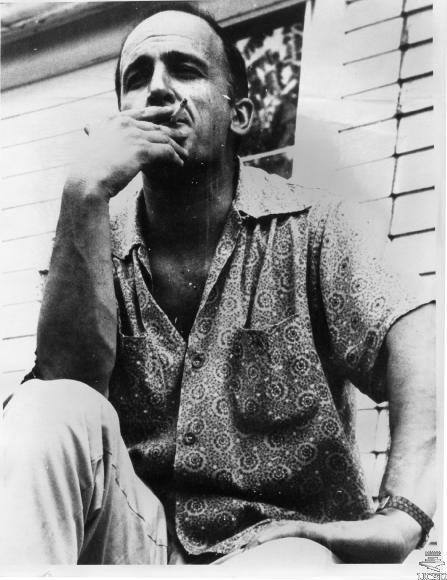Music at the extreme edge of sound, speech and theater

Kenneth Gaburo’s “Maledetto” was performed by Varispeed and thingNY Wednesday at Roulette.
Music is a language, and so commonly understood as such that it seems not worth mentioning. Perhaps that’s why its implications have been so little explored, except for a small number of composers like John Cage and Robert Ashley.
The ensembles Varispeed and thingNY (they share so many members that they might as well be one group) are carrying the torch down this path in the 21st century—Varispeed premiered Ashley’s final opera, Crash in 2014. As performers and composers, they are experimenting at the complex and often magical edge where pitched sounds, musical structure, articulated speech, and theater come together.
Wednesday night at Roulette they added to their portfolio with a concert of two pieces that used articulated speech as their main means of expression and structure. With the audience seated in the round and the performers at a rectangular table (the subtitle was “Musical Voices Around a Table”), the groups delivered an exceedingly rare performance of Maledetto, a work from the fascinating composer Kenneth Gaburo, and the world premiere of Rick Burkhardt’s Passover, commissioned by thingNY.
Gaburo died in 1993 at age 66, and his obscurity makes him difficult to classify—there are currently only six albums of his music available on CD or through streaming services. His primary area of concern was to take the language of music and treat it linguistically, and Maledetto is probably his most substantial achievement.
Part of what he called the “Lingua” series, the title in Italian is a non-specific curse word; it could be “goddamn,” it could be something else. In Maledetto, the word is “screw.” The piece opens with a short stretch of extremely quiet, whistling susurrations from the performers. Once “screw” is spoken, Maledetto follows two parallel paths, one an encyclopedic lecture on the word, from its etymology and usage to its method of manufacture, the other a theatrical and often raucous bandying-about of all the other possible meanings as both verb and noun, from the charmingly archaic to modern slang.
Maledetto would be comfortable to anyone familiar with Ashley, and the performance revealed an enlightening difference between Ashley’s experimental reworking of music drama and Gaburo’s approach, which while immediately avant-garde was also traditional, and funny in a way that was entirely outside of classical music, ancient to contemporary.
This was the performers’ doing—they arranged it so that the lecture was passed around among voices and that the other speaking parts were also shared (the score is set for specific speakers and a SATB chorus). This not only articulated the oratorio form at the core of the piece but revealed that the material works as counterpoint.
Technically, one heard clear articulation, the rising and falling shapes of sentences, different vocal timbres. The performers stumbled over a few words—this is a forty-five minute piece—and the way they recovered showed how exacting the group was about rhythm and time. There is an extended musical interlude, and the performers sang little pearly bubbles of pitch, sounding something like how an older cartoon imagined the sounds of analog computing. It was lovely.
The climax, at least in the musical sense, and finale flowed via a story, told through Dave Ruder, that seems intentionally boring—the narrator talks about his brother-in-law’s job as a bureaucrat coordinating the government’s replacement of current stocks of screws with new models, in mind-numbing detail. It was like Xeno’s paradox, it never got to the point, and Ruder’s smooth, calm delivery held one in place, and the end was surprisingly beautiful.
Passover was also beautiful and stunning. It can be succinctly described as a mix of Stockhausen’s Mikrophonie I in both the sound of the instrumental music and in how the performers are arrayed around a bass, supine on a table, that they play together, and the elliptical, narrative radio art of Joe Frank.
Burkhardt is a playwright as well as composer, and over the stabbing and singing sounds of saxophone, violin, clarinet, bass, and percussion, the performers took turns narrating various vignettes in the life of a young man. The scattered structure was a means of indirection, setting something of a mood about pointless work, our current, farcical social environment, keeping the listener off-balance with a funny use of a meta-narration about problems with the writing.
Expertly delivered by the performers, Burkhardt’s trick was that the last vignette turned out to be nerve-wracking and suspenseful, a tale from the streets too common in real life and headed toward a tragic and senseless conclusion that seemed inevitable. But the story resolved with a theme from the beginning of Passover, and the performance turned into an amazingly powerful and transcendent argument for joy.






